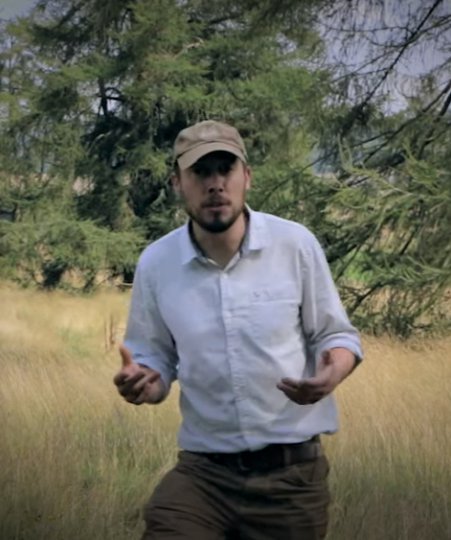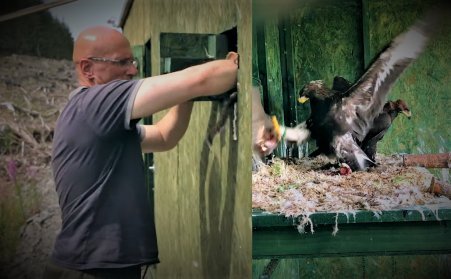PROJECT
BLOG
Restoring
Upland Nature
home to the south of scotland
golden eagle project
PROJECT
BLOG
One of the goals of the South of Scotland Golden Eagle Project is to raise awareness about the translocation process and the fieldwork involved. We have been keen to try and show you exactly what we do when collecting the chicks and how we care for them in the aviaries.
Working with film maker Simon Dures we have filmed the collection and translocation and care of the translocated eagles.
The collection and translocation of golden eagle chicks is done under licence by an experienced team of climbers, vets and project staff.
Watch Part 1 - Catching Golden Eagles below
Speaking of Simon's approach to filming, project manager Cat Barlow said
"Simon’s professionalism was outstanding. It was important that the filming process didn’t cause any additional disturbance or interfere with the chick collection in anyway. Simon managed to film the collection process almost unnoticed to the team."
Simon very kindly sent the following introduction to himself and his work for inclusion in this blog.
"I have been passionate about conservation ever since I can remember. Growing up in the Sussex countryside I was surrounded by wildlife and spent most of my childhood either pond dipping or climbing trees. Unsurprisingly I ended up studying ecology at Edinburgh University, then a conservation biology Masters in Cape Town and finally my PhD with Imperial College London and the Zoological Society of London’s Institute of Zoology. These were far from consecutive and I had a variety of conservation related jobs between studying, most of which were in sub-saharan Africa. After my Masters degree I had a job working for a big safari company as a conservation ecologist in the Okavango Delta in Botswana, one of the most beautiful and wild areas of Africa. While there, I found that there was very little understanding of how lions used this vast wetland landscape and how they interacted with the lions living in the surrounding desert areas. After a few months trying to figure out how I could answer these questions I came up with my PhD research and spent the next few years driving around a vast landscape looking for lions and darting them in the backside to collect samples of their DNA. If you want to know more I have made a video about it on my YouTube channel (https://www.youtube.com/simondures). This was an amazing time of my life, both exciting and scientifically satisfying. While I was writing up my research back in the UK I was frequently asked to give talks about my work. I did this all over the place, at London zoo, in a popup shop on Carnaby Street, at academic conferences and in front of school groups. This is where things started to go wrong, I realised I received so much more satisfaction telling non-scientists about the science I found so exciting than I did communicating with my academic peers.
Watch Part 2 - Releasing Golden Eagles below
So this was where the seed for making films took root. I had always enjoyed photography and at one time had dabbled with the idea of trying to make films, but never with any real conviction. Similarly, I knew that after all the effort of writing peer-reviewed scientific papers very few people would ever see them and, even worse, very few of the people that did would actually have any ability to affect conservation policy. This is not to say the scientific process doesn’t have a huge impact on conservation, it does, it simply takes a very long time. More importantly, I had ended up in science not because I had a passion for it, but because I thought that was the only way to get into conservation and I just kept drifting towards it. After finishing my PhD I chased a girl up to Edinburgh. She was studying the health of raptors across Scotland (the feathery variety, not the ones in Jurassic Park). After coming up to Scotland I had very little work to begin with and so I picked up my photography camera, switched it to video, and started making a couple of short films on her work (after binge watching YouTube tutorials to find out how!). I loved it, so I then made some videos on my own work and, no longer being in Africa, built a set out of Lego and animated the parts I couldn’t film. This then led to a few more videos and eventually, hearing about the south of Scotland Golden Eagle project, I asked if I could film the collection and release of the eagles. I wasn’t expecting them to say yes, but I figured if I didn’t ask…
To my surprise I was asked if I could join them and if I was available the next day! Also, could I make two films, one of the collection and the other on the release of the eagles.
It was amazing! Exceedingly hard work but great fun and fantastic to really see all the work that goes into a project like this. I truly hope the two films give a good indication of all the work that goes into a project like this. It is not a small operation and it involves the help and dedication of a huge number of people. I know how privileged I am to film something like this and so I have two rules I try and keep; the first is to show people all the positive things happening in conservation, we have way too much news focusing on all the negative stuff already; the second is to not get in the way. As a field biologist I know that I can’t ask for a second take and that if the people running the project need me to help with something, the work comes first, the film second, and I must put the camera down and get my hands dirty! That is part of the fun!
My YouTube channel: https://www.youtube.com/simondures
My Website: www.simondures.com


